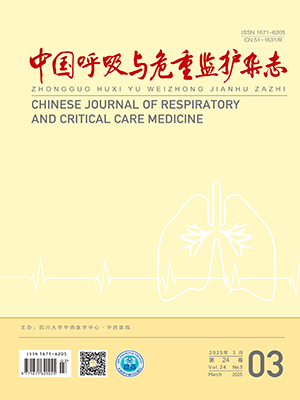Objective To explore the pathogens and clinical features of immunocompromised hosts with septicaemia.Methods The data including underlying diseases, peripheral blood granulocyte count, temperature at blood sampling, management and prognosis)of 160 immunocompromised hosts with septicaemia were analyzed retrospectively.Results 8 patients had twice septicaemia in hospital stay and 3 patients had plural pathogenic septicaemia.171 strains of microorganisms were isolated from blood cultured of 160 septic immuno- compromised hosts in which 156 strains (91.2%) were bacteria, 37 strains(21.6%) were gram positive cocci, 6 strains(3.5%) were gram positive bacilli, 113 strains (66.1%) were gram negative bacilli and 15 strains (8.8%) were fungi. Staphylococcus spp (17 strains) and Streptococcus spp (14 strains) were the predominant pathogens among gram positive cocci and Corynebacteria (5 strains ) were the main pathogen in gram positive bacilli while Escherichia coli (60 strains), Klebsiella pneumoniae (20 strains) and Pseudomonas aeruginosa (15 strains) were the most common bacteria in gram negative bacilli. There were 12 strains of Staphylococcus aureus among the 17 strains of Staphylococcus spp, all of them were methicillin sensitive (MSSA). 17 strains of Escherichia coli, 2 strains of Klebsiella pneumoniae and 1 strain of Klebsiella oxytoca produced ESBLs. Candida was the only pathogens of fungemia in this study in which 4 strains of Candida albicans and 11 strains of non-albicans Candida were detected. There were 120 patients(75%) with granulocytopeniain which 103 patients were agranulocytosis. 70% of the 160 paitents had hyperpyrexia. All patients received broad spectrum antibiotics therapy in the study while 58.8% received antifungal drugs at the same time. 20 patients died of septicaemia and 19 patients gave up therapy because of their conditions deteriorated.The overall improvement rate were 75.6%. Conclusions Bacteria are the main pathogens in septicaemia of immunocom- promised host and fungemia is increasing in recent years.Agranulocytosis is a risk factor of septicaemia in immunocompromised hosts. Hyperpyrexia is one of characteristic signs of these patients.
Citation:
CHEN Yanbin,HUANG Jianan,LING Chunhua,LEI Wei,TAO Yueduo,HE Guangsheng. The clinical analysis of 160 immunocompromised hosts with septicaemia. Chinese Journal of Respiratory and Critical Care Medicine, 2008, 08(1): 30-34. doi:
Copy
Copyright © the editorial department of Chinese Journal of Respiratory and Critical Care Medicine of West China Medical Publisher. All rights reserved
| 1. |
Gea-Banacloche JC,Opal SM,Jorgensen J,et al.Sepsis associated with immunosuppressive medications:an evidence-based review.Crit Care Med,2004,32(Suppl 11):S578-S590.
|
| 2. |
Riedemann NC,Guo RF,Ward PA.The enigma of sepsis.J Clin Invest,2003,112:460-467.
|
| 3. |
Urabe A.Clinical features of the neutropenic host:definitions and initial evaluation.Clin Infect Dis,2004,39(Suppl 1):S53-S55.
|
| 4. |
Mendes AV,Sapolnik R,Mendonça N,et al.New guidelines for the clinical management of febrile neutropenia and sepsis in pediatric oncology patients.J Pediatr (Rio J),2007,83(Suppl 2):S54-S63.
|
| 5. |
Sobel JD.Design of clinical trials of empiric antifungal therapy in patients with persistent febrile neutropenia:considerations and critiques.Pharmacotherapy,2006,26(6 Pt 2):47S-54S.
|
| 6. |
Klastersky J.Management of fever in neutropenic patients with different risks of complications.Clin Infect Dis,2004,39(Suppl 1):S32-S37.
|
| 7. |
Kanamaru A,Tatsumi Y.Microbiological data for patients with febrile neutropenia.Clin Infect Dis,2004,39(Suppl 1):S7-S10.
|
| 8. |
周铁丽,王赛芳,李超,等.医院感染败血症病原菌8年变迁及耐药性分析.中华医院感染学杂志,2006,16:825-827.
|
| 9. |
王丽珍,张天托.耐甲氧西林金黄色葡萄球菌感染的现状和研究进展.国际呼吸杂志,2006,26:917-919.
|
| 10. |
罗雅玲,彭道波,朱建军,等.90年代金黄色葡萄球菌败血症临床分析.中国综合临床,2001,17:595.
|
| 11. |
王辉,吴伟元,陈民钧.肠杆菌科细菌中超广谱β-内酰胺酶(ESBL)的研究.中华微生物学和免疫学杂志,2001,21:676-679.
|
| 12. |
中华内科杂志编辑委员会.血液病/恶性肿瘤患者侵袭性真菌感染的诊断标准与治疗原则(草案).中华内科杂志,2005,44:554-556.
|
| 13. |
中华内科杂志编辑委员会.侵袭性肺部真菌感染的诊断标准与治疗原则(草案).中华内科杂志,2006,45:697-700.
|
| 14. |
Shorr AF,Tabak YP,Killian AD,et al.Healthcare-associated bloodstream infection:A distinct entity? Insights from a large U.S.database.Crit Care Med,2006,34:2588-2595.
|
| 15. |
Falagas ME,Apostolou KE,Pappas VD.Attributable mortality of candidemia:a systematic review of matched cohort and case-control studies.Eur J Clin Microbiol Infect Dis,2006,25:419-425.
|
| 16. |
王爱霞,邓国华.从败血症观察院内真菌感染的动向.中华内科杂志,2002,41:489-490.
|
| 17. |
Zaoutis TE,Greves HM,Lautenbach E,et al.Risk factors for disseminated candidiasis in children with candidemia.Pediatr Infect Dis J,2004,23:635-641.
|
| 18. |
Richardson MD.Changing patterns and trends in systemic fungal infections.J Antimicrob Chemother,2005,56(Suppl 1):i5-i11.
|
| 19. |
丁士芳,周炜,孙恩华,等.念珠菌败血症23例临床分析.中国抗感染化疗杂志,2004,4:268-270.
|
| 20. |
Nakamura T,Takahashi H.Epidemiological study of Candida infections in blood:susceptibilities of Candida spp.to antifungal agents,and clinical features associated with the candidemia.J Infect Chemother,2006,12:132-138.
|
| 21. |
Bakir M,Cerikcioglu N,Barton R,et al.Epidemiology of candidemia in a Turkish tertiary care hospital.APMIS,2006,114:601-610.
|
| 22. |
黄志刚,陆文熊,李明发.真菌性败血症的病因及耐药分析.中华检验医学杂志,2003,26:565.
|
| 23. |
吴安华,文细毛,任南,等.医院内菌血症发病率与病原体分析.中华医学杂志,2003,83:395-398.
|
- 1. Gea-Banacloche JC,Opal SM,Jorgensen J,et al.Sepsis associated with immunosuppressive medications:an evidence-based review.Crit Care Med,2004,32(Suppl 11):S578-S590.
- 2. Riedemann NC,Guo RF,Ward PA.The enigma of sepsis.J Clin Invest,2003,112:460-467.
- 3. Urabe A.Clinical features of the neutropenic host:definitions and initial evaluation.Clin Infect Dis,2004,39(Suppl 1):S53-S55.
- 4. Mendes AV,Sapolnik R,Mendonça N,et al.New guidelines for the clinical management of febrile neutropenia and sepsis in pediatric oncology patients.J Pediatr (Rio J),2007,83(Suppl 2):S54-S63.
- 5. Sobel JD.Design of clinical trials of empiric antifungal therapy in patients with persistent febrile neutropenia:considerations and critiques.Pharmacotherapy,2006,26(6 Pt 2):47S-54S.
- 6. Klastersky J.Management of fever in neutropenic patients with different risks of complications.Clin Infect Dis,2004,39(Suppl 1):S32-S37.
- 7. Kanamaru A,Tatsumi Y.Microbiological data for patients with febrile neutropenia.Clin Infect Dis,2004,39(Suppl 1):S7-S10.
- 8. 周铁丽,王赛芳,李超,等.医院感染败血症病原菌8年变迁及耐药性分析.中华医院感染学杂志,2006,16:825-827.
- 9. 王丽珍,张天托.耐甲氧西林金黄色葡萄球菌感染的现状和研究进展.国际呼吸杂志,2006,26:917-919.
- 10. 罗雅玲,彭道波,朱建军,等.90年代金黄色葡萄球菌败血症临床分析.中国综合临床,2001,17:595.
- 11. 王辉,吴伟元,陈民钧.肠杆菌科细菌中超广谱β-内酰胺酶(ESBL)的研究.中华微生物学和免疫学杂志,2001,21:676-679.
- 12. 中华内科杂志编辑委员会.血液病/恶性肿瘤患者侵袭性真菌感染的诊断标准与治疗原则(草案).中华内科杂志,2005,44:554-556.
- 13. 中华内科杂志编辑委员会.侵袭性肺部真菌感染的诊断标准与治疗原则(草案).中华内科杂志,2006,45:697-700.
- 14. Shorr AF,Tabak YP,Killian AD,et al.Healthcare-associated bloodstream infection:A distinct entity? Insights from a large U.S.database.Crit Care Med,2006,34:2588-2595.
- 15. Falagas ME,Apostolou KE,Pappas VD.Attributable mortality of candidemia:a systematic review of matched cohort and case-control studies.Eur J Clin Microbiol Infect Dis,2006,25:419-425.
- 16. 王爱霞,邓国华.从败血症观察院内真菌感染的动向.中华内科杂志,2002,41:489-490.
- 17. Zaoutis TE,Greves HM,Lautenbach E,et al.Risk factors for disseminated candidiasis in children with candidemia.Pediatr Infect Dis J,2004,23:635-641.
- 18. Richardson MD.Changing patterns and trends in systemic fungal infections.J Antimicrob Chemother,2005,56(Suppl 1):i5-i11.
- 19. 丁士芳,周炜,孙恩华,等.念珠菌败血症23例临床分析.中国抗感染化疗杂志,2004,4:268-270.
- 20. Nakamura T,Takahashi H.Epidemiological study of Candida infections in blood:susceptibilities of Candida spp.to antifungal agents,and clinical features associated with the candidemia.J Infect Chemother,2006,12:132-138.
- 21. Bakir M,Cerikcioglu N,Barton R,et al.Epidemiology of candidemia in a Turkish tertiary care hospital.APMIS,2006,114:601-610.
- 22. 黄志刚,陆文熊,李明发.真菌性败血症的病因及耐药分析.中华检验医学杂志,2003,26:565.
- 23. 吴安华,文细毛,任南,等.医院内菌血症发病率与病原体分析.中华医学杂志,2003,83:395-398.




